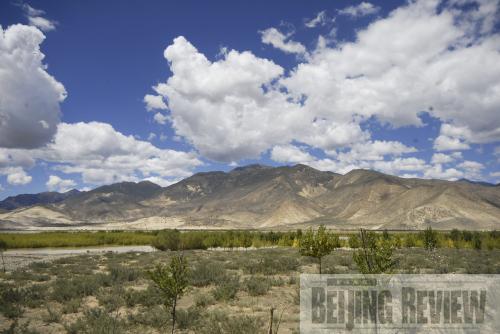|
 |
|
NATURAL GUARDIAN: Forests planted to serve as a windbreak along the Yarlung Zangbo River stand against sandstorms and soil erosion (WEI YAO ) |
Scientific evidence shows the Tibet Plateau, the main body of the Qinghai-Tibet Plateau, is the "starter" and "regulating area" of climate change in the Northern Hemisphere, playing an important role in conserving water resources and controlling the climate. It is the steep Qinghai-Tibet Plateau that changes the westerly wind circulation, and brings the currents of warm and wet air from the Indian Ocean to east China, according to Zhang Yongze, Director of the Environmental Protection Bureau of Tibet Autonomous Region (TEPB). The change of ground surface vegetation and ice cover, notes Zhang, may influence the stability of atmospheric circulation systems across Asia, and even the Northern Hemisphere.
Beginning in March 2005, Tibet began to formulate the Plan on Protection and Construction of the Ecological Security Screen in Tibet (2008-30). The State Council approved the plan on February 18.
According to the plan, within 20 years, China will mobilize all the resources at its disposal to make Tibet a protective screen for regional ecological security. The cost for this plan will total 15.5 billion yuan ($2.27 billion).
This will incorporate 10 projects in three categories. There are five key conservation projects of the natural ecological system— namely natural pasture protection, forest fire prevention and pest control, wildlife protection, reserves construction and protection of important wetlands, as well as traditional fuel alteration in agricultural and pastoral areas.
Four key construction projects are set to restore and rebuild degraded ecosystems, including planting shelter forests and grass and natural pasture upgrading, preventing desert encroachment as well as prevention and control of soil erosion. The other project is to establish and enhance ecological monitoring capabilities to ensure the protection and construction projects are implemented.
In addition, Tibet has formed a systematic, local legal regime concerning environmental protection. It has issued the Regulations for Environmental Protection in the Tibet Autonomous Region, the Rules for Implementation of Management Methods of the Tibet Autonomous Region for Protection of the Environment of Construction Projects and the Methods of the Tibet Autonomous Region for Collection of Sewage Charges.
The region has also drafted the Regulations for Natural Protection in the Tibet Autonomous Region, and Methods of the Tibet Autonomous Region for Comprehensive Management of the Urban Environment.
To protect natural grasslands and forests, the government suspended all tree-cutting activities in natural forests for commercial purposes throughout the region. A project for the protection of natural forest resources on the upper reaches of the Yangtze River in Tibet, for example, has been implemented in the three counties of Jomda, Gonjo and Markam, expressly protecting 460,000 hectares of natural forests and relocating 2,508 households for ecological purposes, according to statistics from the TEPB.
The regional government, meanwhile, has formulated the Forestation Plan of the Tibet Autonomous Region and the Opinions on the Acceleration of Forestation. In addition, along the upper reaches of the Jinshajiang, Lancangjiang and Nujiang rivers and the Yarlung Zangbo River Valley, where sandstorm and soil erosion hazards are serious, a project to reforest cultivated land is also underway.
Up until this July, according to TEPB figures, Tibet had reforested 73,333 hectares of cultivated land, completed forestation of 247,333 hectares, closed hillsides of 558,000 hectares to facilitate forestation and re-planted 26,667 hectares of natural forests that had been previously cut down.
Through effective protection, the forest coverage rate in Tibet has been greatly increased. According to TEPB figures, in the 1950s, Tibet's forest coverage rate was less than 1 percent, but by January 2009, the rate had increased to 11.31 percent, positively influencing the environment.
The region also invested 730 million yuan ($106.88 million) in restoring grazing land to grassland, protecting and restoring 3.06 million hectares of natural pasture.
In addition, the project has facilitated improvement of the environment of the pasture areas. Take Amdo County of Nagqu Prefecture as an example. After implementation of the restoration project, the vegetation coverage rate in the county increased by 18.21 percentage points on average, with vegetation height rising to 7.64 cm, up from 5.72 cm.
Efforts aimed at improving the ecological environment have achieved similarly marked results. With the increased vegetation coverage rate, the number of windy and dusty days in Tibet has been notably reduced. According to TEPB figures, compared with 30 years ago, the number of windy and dusty days was reduced by 32 days in Lhasa, 34 days in Xigaze and 32 days in Zetang. | 